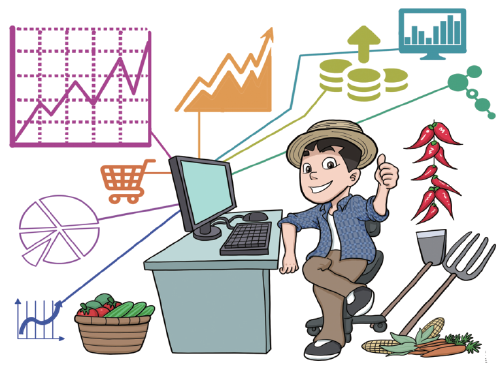Online support


E-commerce is making a big contribution to alleviating poverty
E-commerce has delivered fruitful results in poor areas. By combining leading internet technologies with the poorest areas and population, e-commerce has created the innovative measures to assist in poverty alleviation and rural revitalization.
Data show that online retail sales of goods from poverty-stricken counties in 2019 grew 33 percent year on year, reaching 239.2 billion yuan ($33.8 billion). About 5 million farmers have seen employment secured and income increased.
This has been enabled by the construction of the necessary supporting infrastructure, including internet facilities, transportation, electricity and warehousing. By the end of June 2020, 98 percent of poor villages now have access to optical fiber broadband connections (representing a 28 percent increase over the 70 percent since 2017), all townships and villages where conditions permit have been connected by tarmac or cement roads, 96.6 percent of townships and villages have set up express delivery service stations, and e-commerce service centers have been put in place in all 832 national-level poverty-stricken counties. In a word, all the counties, townships and villages in poor areas have been covered by e-commerce management and logistics networks.
Second, specialty products have been devised to boost poverty alleviation. The poor areas have developed their own specialty products based on realities on the ground, such as black fungus in Zhashui county, Shaanxi province, apples in Lixian county, Gansu province, and honey in Ximeng county, Yunnan province. Inspection and testing on the quality and safety of agricultural products should be stepped up; criteria should be set for origins identification, quality, tracing, refrigeration, preservation, classification, packaging and cold-chain logistics; and certification for novel, special, high-quality and branded products should be promoted to ensure the quality and desirability of brands, so e-commerce poverty alleviation products are able to meet consumers' expectations.
At the same time the supporting systems need to be improved. The grassroots poverty alleviation cadres should mobilize and encourage the poor to engage in e-commerce by helping them understand the benefit of advanced technology; the banks and payment platforms should offer facilitation in micro-credit and modes of payment; the industrial associations and social organizations should provide poor households with standardized services in goods collection, tiered packaging, branding, marketing, logistics and after-sale issues to ensure steady long-term progress of e-commerce poverty alleviation.
Platforms for companies' cooperation should also be established. The State Council Leading Group Office of Poverty Alleviation and Development has already linked producers in poor areas with a large number of e-commerce sales platforms, including JD.com, Suning, Alibaba and Pinduoduo. Take JD.com as an example, during the June 18 online shopping festival this year, the transaction of agricultural products within the first hour was 17 times higher than that of the previous year. And there are over 1.2 million sellers from poverty-stricken counties on Taobao and Tmall currently. For instance, farmers in Xiangyun county of Yunnan province sold all their overstock of potatoes online during the pandemic by using express services of China Post.
Approximately, over 10 million people have received e-commerce training nationwide by the end of 2020 and more than 1 million young talents for e-commerce are ready to work in rural areas, which means that each poor village has one professional at least. We should encourage college students who come from rural areas to return their hometowns after graduation for business start-up and support youth, women, and the physically disabled people in rural areas to engage in e-commerce employment or business start-up. Through the initiative of empowering women to alleviate poverty, 1.22 million women have been trained with e-commerce skills and 636 demonstration centers have been set up.
The government, society and market entities should work together to create synergy of poverty alleviation in China. Through east-west collaboration, the market and technology advantages of the eastern regions can complement the labor, land and natural resources of the western regions. Through programs such as Project Hope and the Guangcai Program, more resources from various actors of society could be mobilized to help win the battle against poverty.
E-commerce has helped overcome remote location, poor transportation conditions and other hurdles and built the bridge for agricultural products in remote areas to access urban markets, which has brought about tangible results in industrial development and increased incomes in poor areas. In particular, e-commerce has solved many urgent problems and helped sell overstocked agricultural products during the pandemic, and sales of such products registered a new record during June 18 online shopping festival this year. The digital economy in rural areas, represented by e-commerce poverty alleviation, has become a new driving force in solving issues related to agriculture, rural areas, and farmers as well as achieving the target of targeted poverty alleviation.
At the same time, it has boosted industrial development in rural areas. By integrating production, supply, sales and purchase, e-commerce has mobilized various forces in society to join the battle against poverty. On the one hand, e-commerce allows the producers in poor areas to access domestic and international supply and industrial chains directly; on the other hand, it changes the traditional way of production and sales, empowers leading companies, cooperatives and self-employed entrepreneurs and incorporates them into more stable coalitions, thus laying a solid foundation for long-term industrial prosperity in rural areas.
What's more, e-commerce is injecting new impetus into rural development. Targeted poverty alleviation underlines the importance of education improvement and ambition formation for the poor. E-commerce energizes the great development initiative and indigenous working aspiration in poor households by training millions of farmers and attracting large numbers of migrant workers to consider home business. Digital technology is the new farm supply, smartphones become the new farming tool and livestreaming turns into the new farm work. By changing the way of thinking and revitalizing innovative mentality for ordinary people, e-commerce is injecting continuous impetus into rural development.
Poverty alleviation through e-commerce is an innovative initiative that China is taking to alleviate poverty in the rural area, which contributes Chinese wisdom and solution to the poverty alleviation all over the world.
The author is the Dean of School of Government and the director of Research Center for Rural Governance at Beijing Normal University. The author contributed this article to China Watch, a think tank powered by China Daily. The views do not necessarily reflect those of China Daily.


































